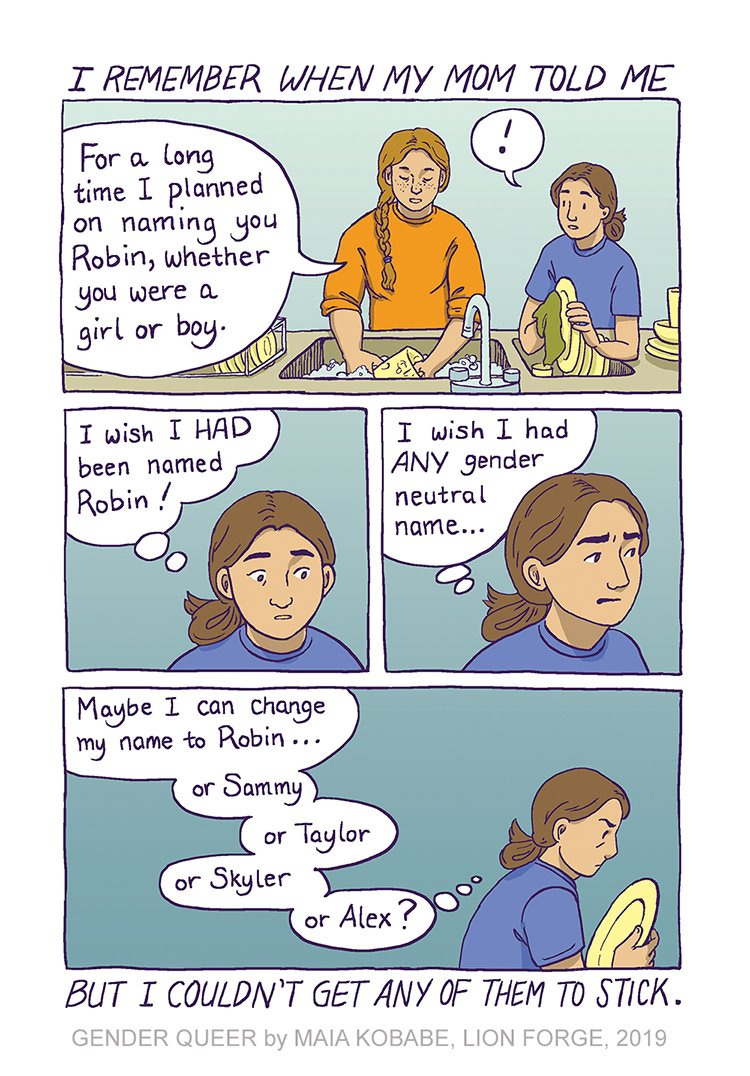In 2021, Maia Kobabe’s debut graphic novel, Gender Queer, became the most challenged book in the country. In this coming of age story, Kobabe wrestles with gender identity, traditional gender roles, and sexuality, identifying as nonbinary and asexual. Kobabe holds nothing back, and it is perhaps this honest mode exploration of gender that has garnered the attention of so many people who seek to ban these discussions. So, we have decided to make Gender Queer our first “asynchronous book club” comic and have posted some discussion questions below.
What role do Maia’s friends and family play in eir self-understanding and coming to terms with asexuality and gender?
Fandoms and fanfiction serve an important part in Gender Queer for Maia and eir friends. What is the role of fan fiction in eir life and in the book? How does it add to eir’s character? The story overall?
Kobabe explains what it is like being nonbinary without being didactic. How does e show this intangible understanding of eir body? How do artistic elements such as style and color contribute to this explanation?
In an interview, Kobabe said “Writing [Gender Queer] was a process of examining my own identity and figuring out how to articulate – in like the clearest, most concise form – what I was trying to say, when I was talking about gender.” How does the structure of the story mirror this exploration?
Maia mentions some big events that happen offscreen, but they aren’t depicted in the book. For example, on page 154, we learn that there has been a family health crisis and the ending of a significant friendship. How do you think this book would be different if we learned more about other parts of Maia’s life?
In the opening, we meet Maia living a rural childhood in Northern California, peeing outside and relaying one of eir earliest gender-related memories. And at the end, e is an adult, giving one-day comics classes at local libraries, still struggling with some anxieties surrounding gender. How do the beginning and the end relate to one another; does it show growth, ultimately?
Drawing activity: Throughout Gender Queer, Kobabe illustrates the dualism of being nonbinary. Is there a culturally-defined spectrum in your life, where society asks you to fall on one side or the other, yet you feel both sides reside in you? Maybe, like Kobabe, this is a gender construct, being neither male nor female, but both or neither. Or, for example, sometimes my students struggle to position their faith and their science studies, worrying that the two cannot share space in their understanding of the world. Think of a binary that you break. How would you draw it?
Feel free to add your questions in the comments section below, or let us know how your own books discussions go. If you are thinking about adding Gender Queer to your library or classroom, here is a helpful page to justify or defend that decision.
Miscellaneous Links
Read Kobabe’s response op-ed in the Washington Post.
We have a review of Jessica Campbell’s RAVE live at Solrad. Check it out here.
We have a review of Time Zone J by Julie Doucet live at the Rumpus! Check it out here.







I read Gender Queer last year when I'd broken my ankle and was ordering books off the internet like nobody's business. I knew nothing about it before reading it, and I loved it. Now after seeing this post, I'm goingvto have to read it again.